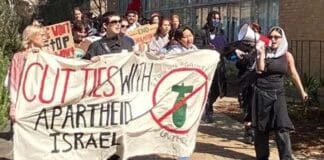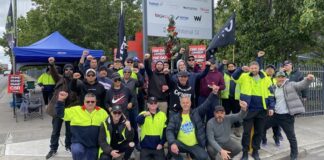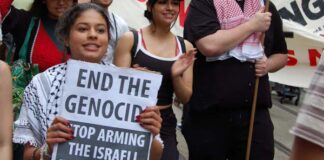When the young Fidel Castro stood trial for an armed attack on the Moncada military barracks in 1953, he dared the court, “Condemn me. It doesn’t matter. History will absolve me.”
Six years later he was Cuba’s prime minister, and led its government for 49 years before formally standing down 2008.
History must judge him both as the freedom fighter whose defiance humiliated US imperialism and as the ruler of a repressive, unequal society.
Born in 1926, Castro grew up in a Cuba that was essentially a colony. Spanish rule had ended only in 1898, partly through the involvement of US troops who picked up where it left off.
The new Cuban constitution allowed the US to intervene whenever its interests were threatened. Guantanamo Bay was “leased” for a US base that still houses the world’s most notorious prison.
US firms bought up the bulk of Cuba’s land and underdeveloped its economy as a sugar plantation.
Cuba was part of a chain of US domination across Latin America. US firms pillaged its resources—from United Fruit turning Guatemala into a “Banana Republic” to the copper giants gouging the Chilean countryside and working thousands of miners to death.
Violence
That was backed up by the violence of US forces and the dictators they propped up, in what president Theodore Roosevelt had called the “Big Stick” policy.
Castro was part of a broad milieu of middle class student nationalists who resented this imperialism and fought it bravely. He focused on armed actions by necessarily small and conspiratorial groups.
His trial for the Moncada attack helped catapult him to the head of Cuba’s opposition. He named his organisation the 26 July movement after the attack’s date.
But it had involved just 140 people—and failed, leaving half of them dead and Castro in jail until an amnesty two years later.
The failures of other opposition forces helped make Castro’s methods seem the only game in town.
President Fulgencio Batista shut down the electoral process and parliamentary opposition in a 1951 coup.
Massive strikes and protests in 1933 had proved the power of Cuba’s working class. But the Communist Party had joined Batista’s first government, demobilised workers and discredited themselves for a generation of radicals.
There were other armed groups. But as Batista’s repression killed their leaders, Castro skilfully manoeuvred himself and the 26 July movement to their head.
Along with a boatload of Cuban exiles—and the Argentinian Ernesto “Che” Guevara—he launched an invasion from Mexico in November 1956, hoping that a mass uprising would greet them.
It didn’t, and most were killed. But the survivors began a long guerrilla war in Cuba’s mountains. The support of the peasant population helped them win battles—and new recruits.
Opposition to Batista grew in Cuba’s cities, including general strikes and an election boycott. The increasingly hated regime also began to rot from within, and its US backers wavered.
Castro used the guerrillas’ prestige to secure his leadership of the opposition—and ensure that his army was the only organisation fit to take power when the regime fell.
This was a heroic fight. But it was nothing like a communist revolution as envisaged by Karl Marx and Frederick Engels. They made it a central principle that “the emancipation of the working classes must be conquered by the working classes themselves”.
In Cuba’s revolution, Castro and his allies did all they could to limit workers’ role to supporting the guerrillas. In the jubilation after Batista’s fall in January 1959, workers did begin to radicalise—and Castro considered this a threat.
In February he complained that, “In working class rallies, banners and demands are put forward in the same tone that was used when there was a non-revolutionary government.
“The masses don’t realise this is their government. One gets the sensation that they still have in mind the idea that government and people are different things.”
Clamped
In little over a year he had clamped down on a reviving democracy inside the trade unions and seized the opposition press.
The new government enacted the land reforms it had promised peasants, while seeking a compromise with the US and the Cuban rich. Their intransigence forced it to radicalise.
The US armed right wing rebels, and threatened to stop buying Cuban sugar. US allies stopped selling Cuba arms and other vital supplies, leading it to buy from Russia. US-owned refineries refused to process Russian oil, so Castro nationalised them.
The trade embargo the US imposed created hardship for ordinary Cubans for decades. US agents carried out terror attacks that killed Cuban civilians.
The CIA under US president John F Kennedy even launched the Bay of Pigs invasion of Cuba by right wing rebels.
Their raid in 1961 failed as spectacularly as Castro’s had five years earlier. But where he had galvanised opposition to Batista, the US’ outrageous moves galvanised support for Castro.
The world had already seen the brutal results of US-backed coups across Latin America, notably in Guatemala in 1954. To topple the reformer Jacobo Arbenz it bombed the capital and sent in troops.
A successful coup in Cuba might have looked more like what was to happen in Chile in 1973, when US-backed General Augusto Pinochet slaughtered thousands. Instead Cuba proved that the US could be beaten, just 50 miles off the US coast.
This was the context for Castro declaring socialism in December 1961—three years after taking power. There were two sides to his defiance.
On one hand Castro was taking a more strident anti-imperialist tone. He appealed to the poor across the Americas, and encouraged Guevara to “spread the revolution”.
He was later to send support and soldiers to the states in southern Africa fighting apartheid.
But in a world polarised by the Cold War, what Castro meant by socialism was more about aligning with one superpower to resist the other. An initially reluctant alliance with Soviet Russia became central to his rule.
This beat the CIA at the cost of becoming a pawn in the nuclear arms race. Cuba survived the US embargo by becoming a captive market for shoddy Eastern Bloc goods—and continuing its dependence on sugar exports.
The new Communist Party that Castro created in 1965 was a tool not of workers’ rebellion from below but of state control from above.
Many of the old Cuban rich had fled, but a new ruling class was forming based on state property—not workers’ power. This left the fundamentals of capitalist society untouched. Exploitation continued, as did the oppression that grew out of it.
Despite major gains in literacy, many Cubans still have bad housing conditions and low wages. This is especially true of the black Cubans who still face institutional racism and were hit hardest by the 1990s “special period” of economic crisis after the Soviet Union’s collapse.
The state’s success in developing health care is rightly celebrated. But it is used more for foreign policy—sending doctors to Venezuela in exchange for oil, for example—than provision for the poor.
Abortion wasn’t fully decriminalised until 1979. Domestic violence remained tacitly accepted. Even today, lack of opportunities drives many women to the sex work that is a major part of Cuba’s tourism industry.
Castro persecuted LGBT people horrifically, with mass arrests, forced labour camps for “deviants” and special education for boys judged effeminate. It culminated in the expulsion of up to 10,000 gays and lesbians from 1980.
Thaw
Castro’s retirement—and a thaw in relations with the US—was an opportunity for his successors to further his retreat from Cold War state capitalism towards a market-based model.
They hope to follow China in opening up to big profits while continuing to repress opposition. If they succeed, like China’s rulers they may find that economic growth brings a bigger and potentially bolder working class.
It is with those workers that any hope for real socialism in Cuba lies.
Castro will be condemned by ruling class hypocrites who hate him for exposing their weakness and refusing to be crushed.
He will be called a murderous tyrant by those who backed Pinochet’s fascist coup and prop up the brutal Saudi regime today.
He made them tremble, and gave encouragement to rebels and anti-imperialists across the world. It was right to support his resistance to the US’ attempts at revenge.
But he cannot be absolved of abusing the idea of communism to rule over a capitalist society.
The socialism he claimed to represent is as important as ever—but making it a reality means workers’ self-activity, not state control from above.
By Dave Sewell, Socialist Worker UK





